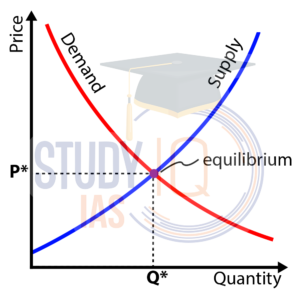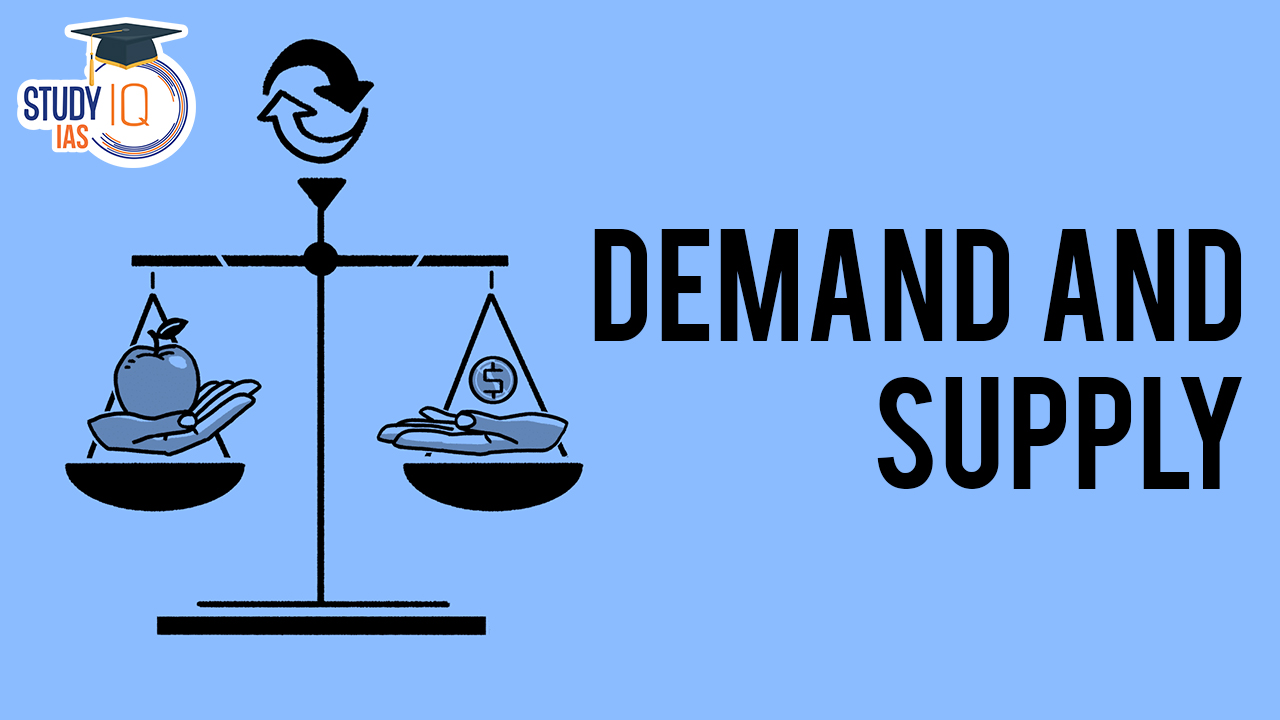Table of Contents
Demand and Supply
Demand and Supply are fundamental concepts in economics that explain how prices and quantities of goods and services are determined in a market economy. Read the complete article to know all about the concept of Demand and Supply and it works in practical life.
Demand and Supply Definition
Demand refers to the desire and ability of consumers to purchase a certain quantity of a good or service at a given price during a specific period. It is influenced by various factors, including consumer preferences, income levels, prices of related goods, and expectations.
Supply, on the other hand, represents the quantity of a good or service that producers are willing and able to offer for sale at different price levels during a particular period. The supply of a product is influenced by factors such as production costs, technology, government regulations, and the availability of inputs.
Read about: Securities and Exchange Board of India
Law of Demand and Supply
Law of Demand
The law of demand states that, all other factors remain constant, as the price of a good or service increases, the quantity demanded decreases, and vice versa. In simpler terms, when the price of a product goes up, people tend to buy less of it, and when the price goes down, people tend to buy more of it.
For example, let’s consider the demand for a popular smartphone. When the price of the smartphone is high, fewer people are willing or able to purchase it. However, if the price of the smartphone decreases, more people will be willing to buy it because it becomes more affordable. This inverse relationship between price and quantity demanded is captured by the law of demand.
Law of Supply
The law of supply, on the other hand, states that all other factors remaining constant, as the price of a good or service increases, the quantity supplied also increases, and vice versa. In other words, producers are willing to supply more of a product as its price rises, and they are less willing to supply it when the price falls.
For example, let’s consider the supply of coffee beans. If the price of coffee beans rises, coffee farmers and suppliers have an incentive to produce and sell more coffee beans because they can earn higher profits. However, if the price of coffee beans decreases, they may reduce their production or find it less profitable to supply the beans. This positive relationship between price and quantity supplied is described by the law of supply.
Together, the law of demand and the law of supply interact to determine the equilibrium price and quantity in a market. When the quantity demanded equals the quantity supplied, the market reaches equilibrium, indicating the point where buyers and sellers agree on a price. Any changes in either demand or supply will cause shifts in the equilibrium, leading to changes in the market price and quantity.
Read about: List of RBI Governors of India
Demand and Supply Elasticity
Demand elasticity and supply elasticity are measures that quantify the responsiveness of the quantity demanded and supplied to changes in price, respectively.
Demand Elasticity
Demand elasticity measures how sensitive the quantity demanded of a good or service is to changes in its price. It calculates the percentage change in quantity demanded divided by the percentage change in price. If the demand for a product is elastic (elastic demand), a small change in price will result in a relatively larger change in quantity demanded.
On the other hand, if the demand is inelastic (inelastic demand), a change in price will lead to a proportionally smaller change in the quantity demanded. Demand elasticity helps determine the extent to which changes in price affect consumer behaviour and total revenue.
Supply Elasticity
Supply elasticity, on the other hand, measures the responsiveness of the quantity supplied to changes in price. It calculates the percentage change in quantity supplied divided by the percentage change in price. If the supply of a product is elastic (elastic supply), a small change in price will result in a relatively larger change in the quantity supplied.
Conversely, if the supply is inelastic (inelastic supply), changes in price will have a proportionally smaller impact on the quantity supplied. Supply elasticity helps assess the ability of producers to adjust their output in response to price changes and is important in analyzing market stability and resource allocation.
Both demand elasticity and supply elasticity are influenced by various factors, such as the availability of substitutes, the time period under consideration, and the degree of necessity or luxury associated with the product. Elasticity values can be positive or negative, where positive values indicate elasticities and negative values indicate inelasticities. Elasticity values greater than 1 indicate relatively elastic responses, while values less than 1 indicate relatively inelastic responses.
Read More: Types of Banks in India
Difference between Demand and Supply
Understanding distinctions between Demand and Supply is essential for comprehending the dynamics of market interactions, price determination, and the allocation of goods and services in an economy. Here is a tabulated explanation about the same.
| Demand | Supply |
| Represents consumer willingness and ability to purchase a product or service at a given price. | Represents the producer’s willingness and ability to offer a product or service for sale at a given price. |
| Shows the quantity of a product or service that consumers desire to purchase at different price levels. | Shows the quantity of a product or service that producers are willing to supply at different price levels. |
| Influenced by factors such as consumer preferences, income levels, prices of related goods, and expectations. | Influenced by factors such as production costs, technology, government regulations, and resource availability. |
| Subject to the law of demand, which states that as price increases, quantity demanded decreases, and vice versa. | Subject to the law of supply, which states that as price increases, quantity supplied increases, and vice versa. |
| Represents the demand curve, which is typically downward sloping. | Represents the supply curve, which is typically upward-sloping. |
| Determines the equilibrium price and quantity in a market when combined with supply. | Determines the equilibrium price and quantity in a market when combined with demand. |
| Changes in demand can be caused by factors such as consumer preferences, income changes, or prices of related goods. | Changes in supply can be caused by factors such as production costs, technological advancements, or government policies. |
| Elasticity of demand measures the responsiveness of quantity demanded to changes in price. | Elasticity of supply measures the responsiveness of quantity supplied to changes in price. |
Read about: Stock Market in India
Demand and Supply Equilibrium
Demand-supply equilibrium is the point in a market where the quantity demanded by consumers equals the quantity supplied by producers. It is achieved when the market price reaches a level where both buyers and sellers agree. The significance of equilibrium is that it determines the market price and quantity, indicating a balanced state where there is no excess demand or supply. It serves as a key reference point for understanding market stability, making informed business decisions, and formulating effective economic policies.
Read More: Indian Financial System
Demand and Supply Curve
The demand and supply curves are graphical representations that illustrate the relationship between price and quantity demanded or supplied in a market. The concept of these curves can be attributed to Alfred Marshall, an influential economist in the late 19th and early 20th centuries.

Uses of Demand and Supply Curve
- Price Determination: Demand and supply curves help determine the equilibrium price in a market where the quantity demanded equals the quantity supplied.
- Market Analysis: They provide insights into market conditions, trends, and fluctuations, aiding in analyzing market behaviour and making informed decisions.
- Forecasting: Demand and supply curves assist in predicting future market outcomes based on changes in demand or supply conditions.
- Policy Formulation: Governments and policymakers use these curves to assess the impact of economic policies on markets and to design effective interventions.
Read More: Types of Banks in India
Demand and Supply Applications
The applications of demand and supply analysis in economics are wide-ranging and have practical implications in various areas. Here are some key applications.
- Pricing and Revenue Management: Helps businesses set optimal prices based on market demand and supply conditions. Example: Airlines adjusting ticket prices based on peak travel seasons and competitor pricing.
- Market Forecasting: Assists in predicting future market trends by analyzing historical demand patterns and supply factors. Example: Clothing retailer forecasting customer preferences to plan inventory levels.
- Government Policy Formulation: Guides policymakers in designing effective economic policies by analyzing demand and supply factors. Example: Adjusting taxes or subsidies to influence demand for specific goods.
- Investment Decision-Making: Helps investors assess market opportunities by analyzing demand and supply dynamics. Example: Analyzing renewable energy demand and supply for investment decisions.
- Resource Allocation: Enables efficient allocation of resources by understanding demand and supply patterns. Example: Investing in educational programs to meet the demand for skilled workers in the technology sector.
Read about: Finance Ministers of India List
Demand and Supply UPSC
Understanding demand and supply is crucial for the UPSC (Union Public Service Commission) exam, as it is a key topic covered in the economics portion of the UPSC Syllabus. UPSC aspirants who opt for subjects like economics as optional or those appearing for the Indian Economic Service (IES) exam need to have a strong grasp of demand and supply concepts. To excel in the UPSC exam, candidates can benefit from UPSC Online Coaching which offers comprehensive coverage of such topics. Additionally, practising UPSC Mock Test that includes economics questions, specifically on demand and supply, allows candidates to assess their knowledge, and enhance their understanding.
Read about: Purchasing Managers Index


 Foreign Contribution Regulation Act (FCR...
Foreign Contribution Regulation Act (FCR...
 Urban Cooperative Banks in India, Functi...
Urban Cooperative Banks in India, Functi...
 Gold Monetisation Scheme, Objectives, Fe...
Gold Monetisation Scheme, Objectives, Fe...





















